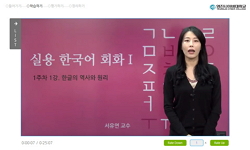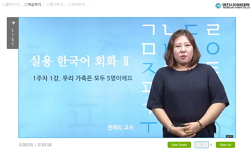This paper compares the pitch accent of the Tokyo dialect (the standard language) of Japanese and that of Pusan dialect in Korean. In the present paper, evidence for this interpretation will be given, along with the structure of the Pusan dialect ac...
http://chineseinput.net/에서 pinyin(병음)방식으로 중국어를 변환할 수 있습니다.
변환된 중국어를 복사하여 사용하시면 됩니다.
- 中文 을 입력하시려면 zhongwen을 입력하시고 space를누르시면됩니다.
- 北京 을 입력하시려면 beijing을 입력하시고 space를 누르시면 됩니다.
부가정보
다국어 초록 (Multilingual Abstract)
This paper compares the pitch accent of the Tokyo dialect (the standard language) of Japanese and that of Pusan dialect in Korean. In the present paper, evidence for this interpretation will be given, along with the structure of the Pusan dialect accent and a comparison with it and that of Tokyo.
Looking Tokyo dialect, it has two oppositions for one-mora words, three oppositions for two-mora words, and so on. It can be represented as Pn=n+1, where ‘Pn’ represent the number of Prosodemes for the accentual unit ‘n’. In the Tokyo accent type, there are n-kernel positions, plus a kernel less type (indicated with an = sign; the ⓪ sign indicates zero-accent), for a total of n+1. Pitch is regarded as ‘movement’, and this is what is indicated; this is quite different from the ‘stepped’ view of accents in which the ‘static condition’ resulting from movement is indicated. In addition, the rise after the initial mora of a phrase, shown by {○[○-} (‘[’ indicates pitch-rise), occurs only before a kernel; single-mora words and words with the kernel at the beginning appear as {[○-}.
Also, in this paper, I will discuss on the details of Pusan dialect in Gyeongsangnam-do of Korea, and report on data obtained during field work there. The aim is to propose a phonological interpretation of the accentual system of Pusan dialect, from renewed angles and also provide a comprehensive analysis of previous literature on them based on the author's research.
Conversely speaking, Pusan dialect has three oppositions for one-syllable words, four oppositions for two-syllable and three-syllable words, and so on. It can be represented as ‘n+1’ more than two syllable as same as Tokyo accent type.
Lastly, in this paper, including accent type of Tokyo and Pusan dialects, will be explained in detail and various particle are described with special emphasis on the tonal patterns and the internal mechanisms.
참고문헌 (Reference)
1 上野善道 , "N型アクセントの一般特性について in : 現代方言学の課題 2" 明治書院 167-209, 1984
2 金次均, "경상도방언의 성조체계(慶尚道方言の声調体系)" 과학사 1980
3 孫在賢, "韓国語のアクセントタイプと分類 in : 日本言語学会(国際基督教大学)第130回大会予稿集" 74-79, 2005
4 風間喜代三, "言語学" 東京大学出版会 2000
5 川上蓁, "日本語アクセント論集" 汲古書院 1995
6 上野善道 , "日本語のアクセント in : 岩波講座日本語 5" 岩波書店 281-321, 1977
7 孫在賢, "日・韓両言語のアクセント体系" 46-49, 2008
8 金田一春彦, "国語アクセントの史的研究:原理と方法" 塙書房 1974
9 許雄, "傍點研究 in : 東方學志 3" 東方學研究所 1955
10 孫在賢, "アクセント調査項目リスト in : アジア․アフリカの言語と言語学 1" 東京外国語大学アジア․アフリカ言語文化研究所 89-128, 2006
1 上野善道 , "N型アクセントの一般特性について in : 現代方言学の課題 2" 明治書院 167-209, 1984
2 金次均, "경상도방언의 성조체계(慶尚道方言の声調体系)" 과학사 1980
3 孫在賢, "韓国語のアクセントタイプと分類 in : 日本言語学会(国際基督教大学)第130回大会予稿集" 74-79, 2005
4 風間喜代三, "言語学" 東京大学出版会 2000
5 川上蓁, "日本語アクセント論集" 汲古書院 1995
6 上野善道 , "日本語のアクセント in : 岩波講座日本語 5" 岩波書店 281-321, 1977
7 孫在賢, "日・韓両言語のアクセント体系" 46-49, 2008
8 金田一春彦, "国語アクセントの史的研究:原理と方法" 塙書房 1974
9 許雄, "傍點研究 in : 東方學志 3" 東方學研究所 1955
10 孫在賢, "アクセント調査項目リスト in : アジア․アフリカの言語と言語学 1" 東京外国語大学アジア․アフリカ言語文化研究所 89-128, 2006
11 服部四郎, "アクセントと方言 in : 國語科學講座Ⅶ、國語方言學" 明治書院 1933
동일학술지(권/호) 다른 논문
-
- 한국일본학회
- 장근수
- 2009
- KCI등재
-
- 한국일본학회
- 황익구
- 2009
- KCI등재
-
오오카 쇼헤이(大岡昇平)의 『포로기(俘虜記)』론─점령 하의 시대인식과 전쟁책임인식─
- 한국일본학회
- 김효순
- 2009
- KCI등재
-
- 한국일본학회
- 오성숙
- 2009
- KCI등재
분석정보
인용정보 인용지수 설명보기
학술지 이력
| 연월일 | 이력구분 | 이력상세 | 등재구분 |
|---|---|---|---|
| 2027 | 평가예정 | 재인증평가 신청대상 (재인증) | |
| 2021-01-01 | 평가 | 등재학술지 유지 (재인증) |  |
| 2018-01-01 | 평가 | 등재학술지 유지 (등재유지) |  |
| 2015-01-01 | 평가 | 등재학술지 유지 (등재유지) |  |
| 2011-01-01 | 평가 | 등재학술지 유지 (등재유지) |  |
| 2009-01-01 | 평가 | 등재학술지 유지 (등재유지) |  |
| 2007-04-30 | 학술지명변경 | 외국어명 : 미등록 -> The Korean Journal of Japanology |  |
| 2007-01-01 | 평가 | 등재학술지 유지 (등재유지) |  |
| 2005-01-01 | 평가 | 등재학술지 유지 (등재유지) |  |
| 2002-01-01 | 평가 | 등재학술지 선정 (등재후보2차) |  |
| 1999-07-01 | 평가 | 등재후보학술지 선정 (신규평가) |  |
학술지 인용정보
| 기준연도 | WOS-KCI 통합IF(2년) | KCIF(2년) | KCIF(3년) |
|---|---|---|---|
| 2016 | 0.5 | 0.5 | 0.44 |
| KCIF(4년) | KCIF(5년) | 중심성지수(3년) | 즉시성지수 |
| 0.38 | 0.34 | 0.725 | 0.25 |




 eArticle
eArticle





